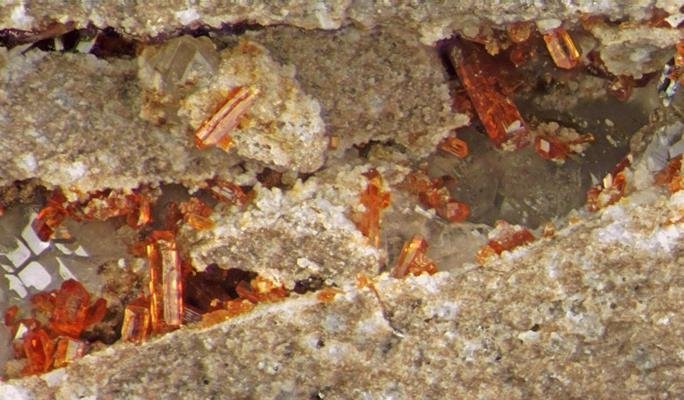Miarolitic cavities or pods refer to small, irregular cavities in intrusive or plutonic igneous rock, usually lined with well-formed or euhedral crystals.
These cavities are relatively small, i.e., on a centimeter scale, and form from segregated fluid phases trapped in plutons.
When exposed to the surface by erosion or uplift, miarolitic cavities appear as small, widely spaced, irregular structures, usually several crystal diameters apart.
These cavities will have euhedral or well-formed coarse-grained mineral clusters with voids at their center left behind by fluids that later escape.
Minerals lining miarolitic pods are well-formed because they grow inward to unimpeded fluid-filled voids. This allows the formation of euhedral crystals, which are well-formed, sharp, and easy-to-recognize faces.
Larger miarolitic pods may sometimes show mineral zoning, like in pegmatites. In zoned pods, the mineral composition will vary from outside inward.
Additionally, some miarolitic cavities are often druzy, i.e., they have an aggregate of small, well-formed projecting minerals that line their inner surface. These minerals usually project inwards towards the hollow.
Compositionally, most miarolitic pods have a mineral composition similar to the surrounding plutons. However, they can have exotic minerals due to the concentration of incompatible minerals.
Lastly, the characteristic texture created by these cavities is known as miarolitic texture or fabric.

Where do miarolitic pods occur?
Miarolitic cavities are most common in plutonic rocks like granitic pegmatites. These pegmatites often have these voids at their core.
However, they can also form in other plutonic rocks, including granite, nepheline syenite, diorite, and gabbro.
Lastly, they are often associated with large plutons like stocks and batholiths but can form in cone sheets or ring dikes.
Miarolitic cavities vs. vugs
Miarolitic cavities are similar to vugs in plutonic rocks. They are both small irregular cavities formed from exsolution of volatiles. Also, they are lined by minerals, some of them druzy.
However, unlike miarolitic cavities, vugs can form by other means. For example, folding and faulting from tectonic movements can create these cavities.
Also, acidic solutions can dissolve rocks, especially those high in carbonates or limestone, forming cavities, some of them very large. For instance, some vugs can enlarge during karst development, forming caves and caverns.
How are miarolitic cavities formed?
Miarolitic cavities form during the crystallization of the last, water-rich magma melts in plutons. Such magmas form when most of the pluton has crystallized.
This residual melt is high in water, other volatiles, and some incompatible elements. All these are not usually incorporated into the structures of rock-forming minerals. Therefore, they will progressively concentrate in the residual water-rich melt.
Some of the common incompatible elements include lithium, beryllium, niobium, tin, fluorine, rubidium, boron, tantalum, etc.
When the concentration is so high, a fluid phase may form. This segregated phase can remain trapped in plutonic rocks, forming miarolitic pods or cavities.
Alternatively, some volatiles may exsolve to form bubbles, like vesicles formed in volcanic rocks like basalt. Such are common when depths are shallower, i.e., lower pressure.
However, unlike vesicles, these cavities have irregular shapes that are not spherical. This happens because crystal faces in magma mushes and high viscosity constrain bubbles, making them irregularly shaped.
Lastly, minerals like quartz, feldspar, and mica will line the walls of miarolitic cavities. Also, more unusual minerals like topaz, fluorite, beryl, fluorite, spodumenes, lepidolite, cassiterite, and molybdenite. Some of these minerals form druses.
Importance or significance
The miarolitic texture is evidence that, indeed, a magmatic volatile phase does exsolve. Otherwise, they will not form.
Secondly, some are lined with valuable, gem-quality minerals like beryl (aquamarine), spodumene, and topaz.
